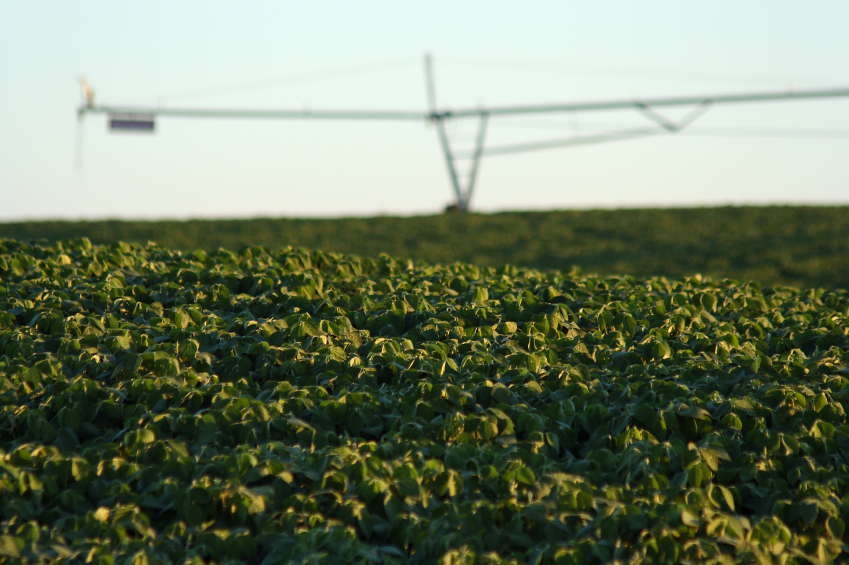
As farmers and landowners gear up for the 2017 growing season, the land they are preparing continues its downward trend in value that has characterized the last three years. How much have Nebraska farmland values decreased since 2016? The University of Nebraska-Lincoln’s annual Nebraska Farm Real Estate Market Survey delved deeper into the land market trends in the Cornhusker state.
According to preliminary findings from the survey, the weighted average farmland value had declined by approximately 10 percent over the past year, to $2,805 per acre, marking the third consecutive year of of decline, and down a total of approximately 15 percent since its peak in 2014 at $3,315 per acre.
When taking into account land classifications, dryland cropland with irrigation potential took the biggest hit, with a 13 percent decline. This was followed closely by tillable grazing land, which declined 12 percent.
Sustained lower commodity prices seem to be the main reason for these declines, with producers less likely to develop these land classes due to less economic incentive. Survey participants also indicated lowered expectations that commodity prices will improve for the foreseeable future, also contributing to these value declines. Participants also cited regulatory policies in place that would further retard development of this particular land class.
Following dryland cropland with irrigation potential and tillable grazing land, dryland cropland without irrigation potential and nontillable grazing land had the third largest price decline since February 2016 at 10 percent, with the sharpest rates of decline occurring in the Central, Southwest, and Southern districts at a rate of 15 percent.
Lastly, gravity and center pivot irrigated cropland reported the lowest rate of decline, ranging between 6 and 4 percent. Northwest, Southwest, and Southeast parts of the state dropped more than other districts, at 13-16 percent vs. 5-7 percent. Participants to the survey were pessimistic about these rates improving in the near future, citing the availability of water and policies affecting its use as potential negative forces. However, participants also stated that technological advancements in irrigation management may alleviate some of these challenges.
Similarly, rental rates for agland in Nebraska also declined due to sustained lower commodity prices. As property tax levels continue to be a burden on landowners, negotiating equitable rental rates remain challenging.
Irrigated cropland rental rates declined between 5 and 10 percent, with center pivot irrigated cropland declining from 9-12 percent. Pasture and cow-calf rental rates also fell 5-15 percent across Nebraska, with the strongest rate of decline occurring in regions noting the highest grazing rates over the past several years.
Certainly, these trends aren’t welcome news to farmers and landowners. Hopefully, the Nebraska Legislature will continue to push for solutions to the ever-burgeoning property taxes that burden producers across the state, which would go a very long way in alleviating the issues facing Nebraska farmers.
If you have concerns about the financial health of your farming operation, please don’t hesitate to give us a call. We are happy to put together a plan with you to help you weather the storm.
Source consulted: “2017 Trends in Nebraska Farmland Markets: Declining Agricultural Land Values and Rental Rates.” Agricultural Economics. University of Nebraska-Lincoln. 15 Mar. 2017. Web. 28 Mar. 2017.

As farmers begin to wrap up harvest 2016 amidst low grain prices, it’s no surprise that cash rental rates across the state and region have followed suit. The USDA released its annual update on farmland market conditions in August, and highlighted the drop in US land values and rental rates nearly across the board.
Nationally, the average cropland cash rent fell 6 percent—$136 per acre lower—in 2016, after the long upward climb that began in 2008. Since 1998, the only other time the cash rental rate has seen a decline was in 2007, with a 3 percent drop.
Despite the overall decline, overall changes at the state level were much more variable. In the Midwest, Minnesota and Iowa showed the greatest decline in cash rents, similar to most other Midwest and Great Plains states. The only two states to show in increase were Michigan and Wisconsin.
Nebraska’s farmland real estate value—the value of all land and buildings on farms—decreased 3.3 percent from 2015, averaging $2,950 per acre. Similarly, Nebraska’s cropland value fell 4.3 percent from 2015, with an average value of $4,850 per acre.
Nationally, average rental rates for pasture land also saw declines in 2016—7 percent in total from 2015 highs, although Nebraska pastureland increased $40 per acre from 2015, at $910 per acre.
More specifically, for Nebraska, the dryland cropland value averaged $3,800 per acre, down $170 from 2015, while irrigated cropland averaged $6,560 per acre, also down from 2015’s $310 per acre average.
Looking expressly at cash rental rates in the Cornhusker state, renters paid less to landlords in 2016 than in 2015. Irrigated cropland cash rent average $243 an acre, an $11 decrease from 2015. For dryland cropland, rents averaged $150 per acre, down $10 from the previous year. Pastureland cash rental rates average $24 per acre, down $4.50 from 2015.
While cash rental rates are falling, a survey recently conducted by ProFarmer found that more farmers may choose to walk away from ground that can’t be renegotiated—another possible contributing factor to the trend, aside from other more obvious factors, chiefly lower commodity prices.
ProFarmer LandOwner newsletter editor Mike Walsten said, “According to our survey, we found that 44 percent of members and subscribers are willing to walk away from a cash lease if that lease is not lowered going into 2017.”
Based on these numbers—and similar sentiments shared elsewhere—cash rent conversations could be tough. Facing the decision to buy, sell, or walk away from pricey cash rents will be difficult the next year, but trying to keep emotions out of that decision is encouraged by farm managers.
Are you facing concerns about your rented ground, or nervous about looming cash rental negotiations? Please let an experienced UFARM land manager take the pressure off. We have the practical knowledge and necessary skills to help both parties reach a mutually agreeable rental price during this adjustment period.
UFARM offers a full range of Nebraska land management services, including real estate sales, rural property appraisals, consultations and crop insurance. UFARM has operated in Nebraska since the early 1930’s. If you have questions about yields and productivity on your rented farmland, give the UFARM managers contact us today!
Sources consulted: “NE Farm Real Estate Values Down 3 Percent from 2015; Cash Rents Also Down.” UNL Cropwatch. University of Nebraska-Lincoln. 05 Aug. 2016. Web. 26 Oct. 2016.Morgan, Tyne. “More Farmers Walking Away from Pricey Cash Rents.” AgWeb.com. Farm Journal. 25 Oct. 2016. Web. 26 Oct. 2016.Widmar, David. “Most States See Cash Rental Rates Fall, Economist Says.” Agriculture.com/Successful Farming. Meredith AgriMedia. 24 Oct. 2016. Web. 26 Oct. 2016.

Amid the many challenges that face farmers and landowners across Nebraska, a continued concern is high property taxes. With the plummeting grain prices over the last 3 years, and with the skyrocketing property tax rates of the last 10 years—which have increased 176 percent—it’s no wonder landowners and producers are hoping for property tax relief at the legislative level.
Toward the end of this year’s 2016 legislative session, lawmakers were able to advance LB 958 and LB 959, which provides additional money to the state’s property tax credit program, valuing ag land at 90 percent versus 75 percent of market value for the credit program, tightens limits on budget growth and levy increases for all local governments, and slows the rise in government-assessed cropland values across the state—measures that proponent and Governor Pete Ricketts calls “tools to help local governing entities control spending.”
In a state where 51 percent of total school spending comes from property taxes, in comparison to the national average of 32 percent—this is welcome news to landowners.
In calculating real estate taxes, all land is taxed based on either market value or fair use value. Often farmland appraisals are based on a formula for Current Agricultural Use Value (CAUV), or the income a farmer can expect to earn based on factors including grain prices, farm rental rates, soil type and productivity, production expenses, and interest rates, among other variables.
As such, the record high crop prices in 2012 and the all time high farm incomes of 2013 are now factoring in to property tax appraisals. Given the plummeting farm incomes since then, combined with low interest rates, which also push taxes up for landowners, there is a perfect storm brewing for potential tax problems, despite the property tax relief legislation.
With this much money on the line, it’s little surprise that owners of Nebraska farmland often turn to professional land managers to provide them with highly accurate appraisal services. UFARM’s own agricultural valuation professionals have years of combined experience in local land markets with which to provide their clients with a clear account of their property’s value and potential.
Using the latest appraisal technology, UFARM appraisers are experienced in completing all the necessary reports for estate valuation, loan collateral, sales analysis, and property partition.
In addition, UFARM has certified rural appraisers on staff, offering appraisals through each of our offices across the state. These services include documented market value estimates that are carefully researched, written to withstand challenge, and provide a precise picture of a landowner’s property value.
In addition to property tax purposes and property tax appeals, an accurate value appraisal is important for a number of other, equally significant reasons, including:
-buying, selling, exchanging, or dividing real estate
-estate planning and gifting
-loan evaluations
-litigation
-condemnation proceedings
-eminent domain for roadways, pipelines, or electrical lines
When it comes to determining the value of your land, count on the most experienced appraisers. Feel free to contact UFARM for all of your appraisal needs.

Amid continuing low commodity prices, farmers across the state are facing challenges heading into the 2016 growing season. As expected, land values and rental rates are following suit. According to preliminary findings from the latest University of Nebraska–Lincoln Farm Real Estate Market Survey, ag producers will contend with tighter margins for servicing rent and making debt payments.
Overall, land values in the Cornhusker state decreased an average of 4 percent over the last 12 months, with the average price per acre at $3,135, down $115 per acre since 2015. This is the second consecutive year that values have decreased in the state. Rental rates for agricultural ground in Nebraska peaked in 2014 and 2015 for cropland and grazing land, respectively.
Survey results, by district, were as follows: northwest, $820 (-5 percent); north, $1,270 (-5 percent); northeast, $6,095 (-1 percent); central, $3,780 (-4 percent); east, $7,025 (-1 percent); southeast, $5,685 (-5 percent); south, $4,140 (-10 percent); and southwest, $2,010 (-3 percent).
For dryland and irrigated cropland, the decline was about 5-10 percent for 2016, with higher rates of decline indicated for western portions of the state. The survey also found that rates of decline were higher in parts of the state with record rent levels in 2015.
Other survey results found that the largest price decline—17 percent—occurred in the hayland category. Following the demand for forage following the 2012 drought, and the corresponding willingness on the part of cattle producers to pay more for hayland, the subsequent moisture recovery that occurred has led to the price of hay dropping. Some of the largest decline in hayland has been in the north and northwest districts of the state.
Gravity-irrigated and center pivot-irrigated land showed the next highest rate of decline of about 6 and 4 percent. The same is true of dryland cropland with irrigation potential.
The only land class that remained unchanged or showed small price increases was in dryland cropland without irrigation or tillable grazing land potential.
Rental rates for dryland and irrigated cropland declined from 2-10 percent, with pasture and cow-calf rental rates also declining about 5-10 percent across the state, after setting records in 2015. The average monthly rental rate for a 5-month grazing season averaged about $55 per month or $275 for the grazing season, with survey participants attributing the dollar difference to varying levels of service agreed to in leases between landlord and tenant.
Landlords reported higher landownership expenses as property taxes continue to increase, and rental negotiations have centered on these challenges.
Looking ahead, survey participants noted that financially sound producers may still have the ability to secure long-term financing at favorable interest rates. However, meeting annual debt payment on newly purchased property at the current commodity prices will remain tough.
With recent weather trends hinting at the possibility of an early spring, along with rumors of a quick change from El Nino to La Nina, which could bring about hot and dry summer conditions, prices may change for the better. Until then, farmers will continue to focus on managing input costs as they prepare for the planting season.
Source consulted: “Nebraska Ag Land Values Down 4%; Rental Rates Down 2-10%.” CropWatch. University of Nebraska-Lincoln. 11 Mar. 2016. Web. 15 Mar. 2016.
 It’s January, and as many are setting their personal goals for 2015, farmers and agriculture economists are also keenly interested in what the new year will bring for ag producers. With 2014’s lower commodity prices in mind, farmers are paying close attention to rumors of rising interest rates in 2015.
It’s January, and as many are setting their personal goals for 2015, farmers and agriculture economists are also keenly interested in what the new year will bring for ag producers. With 2014’s lower commodity prices in mind, farmers are paying close attention to rumors of rising interest rates in 2015.
According to Fortune magazine, the Federal Reserve will begin to raise interest rates sometime in the coming year. The rate hikes signal a tapering of the Fed’s “quantitative easing” strategy of the last several years, the goal of which was to bring down long-term interest rates in an effort to stimulate business borrowing and spur the economy during the recession. While opinions vary regarding the timing of the increases, two officials with the U.S. Central Bank said the timing will depend upon the economy, although most agree that it will take place within the next 12 months.
What do these rising interest rates mean for your farming operation? Rising interest rates can spell disaster for some farming operations, as was the case when rates spiked in the 1980s. It’s important to gauge the events on the horizon, and take steps now to cushion yourself from the effects. Here are three things to keep in mind.
The first is to consider re-financing now, even if it’s only a short-term, one-year restructuring. It’s far easier to make changes sooner than later, when farm values are still relatively high and income statements are favorable from the last several years. According to Bob Campbell, senior vice president of Omaha-based Farm Credit Services of America, “If you wait a year or two and the cost of production is higher and your cash is drained and you have no cash flow, you won’t have the strength in your balance sheet and income statement to re-finance. Now is the time to tweak your income statement to give it some breathing room.”
Another thing for producers to keep in mind heading into 2015 is to manage their taxes wisely, and ensure that they aren’t heading into a new year with no equipment write-offs and no money to pre-pay expenses—income but no deductions. Ag finance experts encourage producers to pay attention throughout the year and make the necessary decisions sooner than later.
Finally, it’s important to keep in mind the effect of rising interest rates on land values. Experts predict that a rise in interest rates, coupled with a stronger U.S. dollar and bearish commodities outlook, will drive down land values. AgriLife Extension Economist Dr. Levi Russell has this to say:
[Rising interest rates create] an incentive for landowners to sell land and buy other assets with similar risk and higher returns, such as bonds. While a rise in cash rents would mitigate this factor, increasing the return to land (through cash rent) will likely be more difficult due to a bearish commodity price outlook. Additionally, increased interest rates also strengthen the dollar relative to other currencies, which puts downward pressure on exports. This would also be bearish for commodity prices. The implication is that farmland prices will likely fall as rates begin to rise.”Are you concerned about what higher interest rates will mean for your goals? Feel free to contact a UFARM land manager –we are happy to hear your concerns and help you form a smart strategy for your land.
Sources consulted: “Economist: Low agricultural commodity prices, potential rising rates could lead to land value declines.” AgriLife Today. Texas A&M Agrilife. 09 Oct. 2014. Web. 05 Jan. 2015. Nitchie, Don. “Rising Interest Rates Will Impact Agriculture.” University of Minnesota Extension. University of Minnesota. Web. 05 Jan. 2015. Reuters. “Two Fed officials say interest rates to rise in mid-2015.” Fortune. Time.com. 09 Oct. 2014. Web. 05 Jan. 2015.Williams, Elizabeth. “Farm Finances: Prepare Now for Rising Interest Rates.” AgFax.com.AgFax Media, LLC. 24 Oct. 2014. Web. 05 Jan. 2015.

It’s no secret that farmland values have boomed over the last decade. Many farmers and outside investors have bought and continue to buy up land to pad their investment portfolios. Despite the decreasing commodity values of the last year, many economists continue to be optimistic about buying land as a long-term investment.
Commodities investor Jim Rogers, who founded the Rogers International Commodities Index, is part of an increasing number of farmland investors hoping to benefit from the growing world population’s need for food. With a world population that is expected to grow from 7 billion to 9 billion by the year 2050, and the projected arable land to decrease steadily in the same time span, the case for farmland investment worldwide is a good one.
Says Rogers, “More people need to get into farming; otherwise, we won’t have any food. I’m still wildly optimistic about the future of agriculture worldwide.”
There are many other factors contributing to the desirability of quality farmland. One is that the increase in population will occur largely in the developing world, where rising incomes will contribute to higher meat consumption. Increasing livestock consumption creates a demand for grain and water, so farmers worldwide will rise to the demand by putting out more crops and farming more acres. Another driver of the farmland market boom is the demand for biofuels, such as ethanol.
These factors, combined with a worldwide leveling off of yields after the many advances of the last 40 years, put owners of quality farmland into excellent position to benefit financially in the long-term.
While outside investors continue to be bullish about quality farmland, others emphasize the need use caution before jumping headfirst into the farmland market. While land values have risen dramatically over the last decade, they are set to level off as commodity prices do the same.
Purdue University Extension agriculture economist Craig Dobbins says, “The next couple of years for farmland values are going to be a little less certain than the last few years have been. Commodity prices have come down significantly in the last year, so these large returns we’ve kind of become accustomed to for the last few years have now shrunk.The probability of short-term farmland values staying flat or seeing a small decrease is much bigger than the probability that we’re going to see another double-digit increase.”
While farmland continues to be a solid way to invest your capital for the long-run, it’s important to evaluate your financial situation carefully before buying land in 2015.
Are you considering buying land, or do you have concerns about the value of your farmland going forward? Contact UFARM—we’re happy to talk with you about your land asset. UFARM offers a full range of Nebraska land management services, including real estate sales, rural property appraisals, consultations and crop insurance. UFARM has operated in Nebraska since the early 1930’s. Contact us today!
Sources consulted: Murphy, Richard McGill. “The best long-term real estate investment: Farmland.” CNBC.com. CNBC. 24 Mar. 2014. Web. 16 Dec. 2014. Stewart, Jennifer. “Farmland value shift signals need for cautious purchasing.” Purdue University News. Purdue University. 13 Feb. 2014. Web. 16 Dec. 2014.
 As farmers across the state are becoming reacquainted with their combines, and are bringing in high yields, they are also dealing with lower grain prices. With grain prices heading south, it’s no surprise that Nebraska land values are being similarly affected. Nebraska farmland values remain strong, but a slow down is beginning to show. Non-irrigated farmland in the Nebraska rose 3.7 percent from a year earlier, while irrigated farmland rose 2.3 percent.
As farmers across the state are becoming reacquainted with their combines, and are bringing in high yields, they are also dealing with lower grain prices. With grain prices heading south, it’s no surprise that Nebraska land values are being similarly affected. Nebraska farmland values remain strong, but a slow down is beginning to show. Non-irrigated farmland in the Nebraska rose 3.7 percent from a year earlier, while irrigated farmland rose 2.3 percent.
Farmers are beginning to feel the pinch of smaller profit margins and this will eventually be reflected in land prices. According to an index from ag bankers, second quarter farm income fell to a reading of 80, down from 100 from 2010 to the middle of last year. According to the survey, “Farm income remained well below year-ago levels due to falling crop prices and poor winter wheat yields. With summer rains easing drought conditions, the potential for record crop production this fall could keep prices low and shrink profit margins further.”
Grain prices continue to be a worry and farmers and market analysts are anxiously anticipating Friday’s next WASDE report from the USDA to further gauge grain futures. While the outlook doesn’t look great, all is not total doom and gloom. Besides farmers who sold some of their 2014 crop above today’s market prices, federally subsidized crop insurance and new programs in the latest Farm Bill will provide safety nets and perhaps allay the fears of many producers.
Despite these safety nets, however, farmers and landowners undoubtedly face challenges. Experts expect the agricultural sector to enter a downward cycle, though it’s unclear if this will be a multi-year issue or not. Interest rates may see an increase as well in the near future, also undoubtedly at the forefront of many farmers’ minds.
In addition to these challenges, farmers face tough decisions about when to sell their grain. However, according to Ainsworth West Plains Bank president Michael Kreycik, farmers should be able to absorb a few years of low prices and even losses. He says, “I think our loan customers are in a better position now than they were in 1980 to absorb a higher rate of interest and softening of land prices.” A key factor for many farmers and landowners will be if interest rates begin to rise—if so, that could pose a problem for many.
At any rate, this could be a test for the 2014 Farm Bill’s safety nets, as some economists are predicting substantial payments under the new law to grain farmers this year.
Do you have concerns about changing land values? Are you looking for ways to protect your land investment? Contact a UFARM land manager—they’ll help you make the right decisions.
United Farm and Ranch Management (UFARM) is a Nebraska-based company devoted to meeting landowners’ needs. UFARM offers a full range of Nebraska land management services, including real estate sales, rural property appraisals, consultations and crop insurance. UFARM has operated in Nebraska since the early 1930’s. Contact Us.
Sources consulted: Hubbard, Russell. “Fed Survey: Lower Grain Prices Limit NE Farmland Values.” Omaha.com Money. 15 Aug. 2014. Web. 06 Oct. 2014.; Jordon, Steve. “With No Sign of Increased Demand, Farmers Battle Falling Corn Prices.” Omaha.com Money. 03 Aug. 2014. Web. 06 Oct. 2014.
GET TO KNOW US
Recent Posts
- Lancaster County, Nebraska, Land for Sale May 28, 2025
- Lincoln County, Nebraska, Land for Sale May 2, 2025
- Lincoln County, Nebraska, Pasture/Hunting Land for Sale April 30, 2025
- Seward County, Nebraska, Surface Irrigated Cropland April 11, 2025
- Factors That Affect the Value of Agricultural Land: A Complete Guide for Buyers and Sellers March 13, 2025
- Thurston and Dakota Counties, Nebraska, Simulcast Auction – March 6, 2025 January 30, 2025
OFFICE LOCATIONS
Lincoln, Nebraska
402-434-4498
Kearney, Nebraska
308-237-7662
Norfolk, Nebraska
402-371-0065
North Platte, Nebraska
308-532-4991
FOLLOW US

